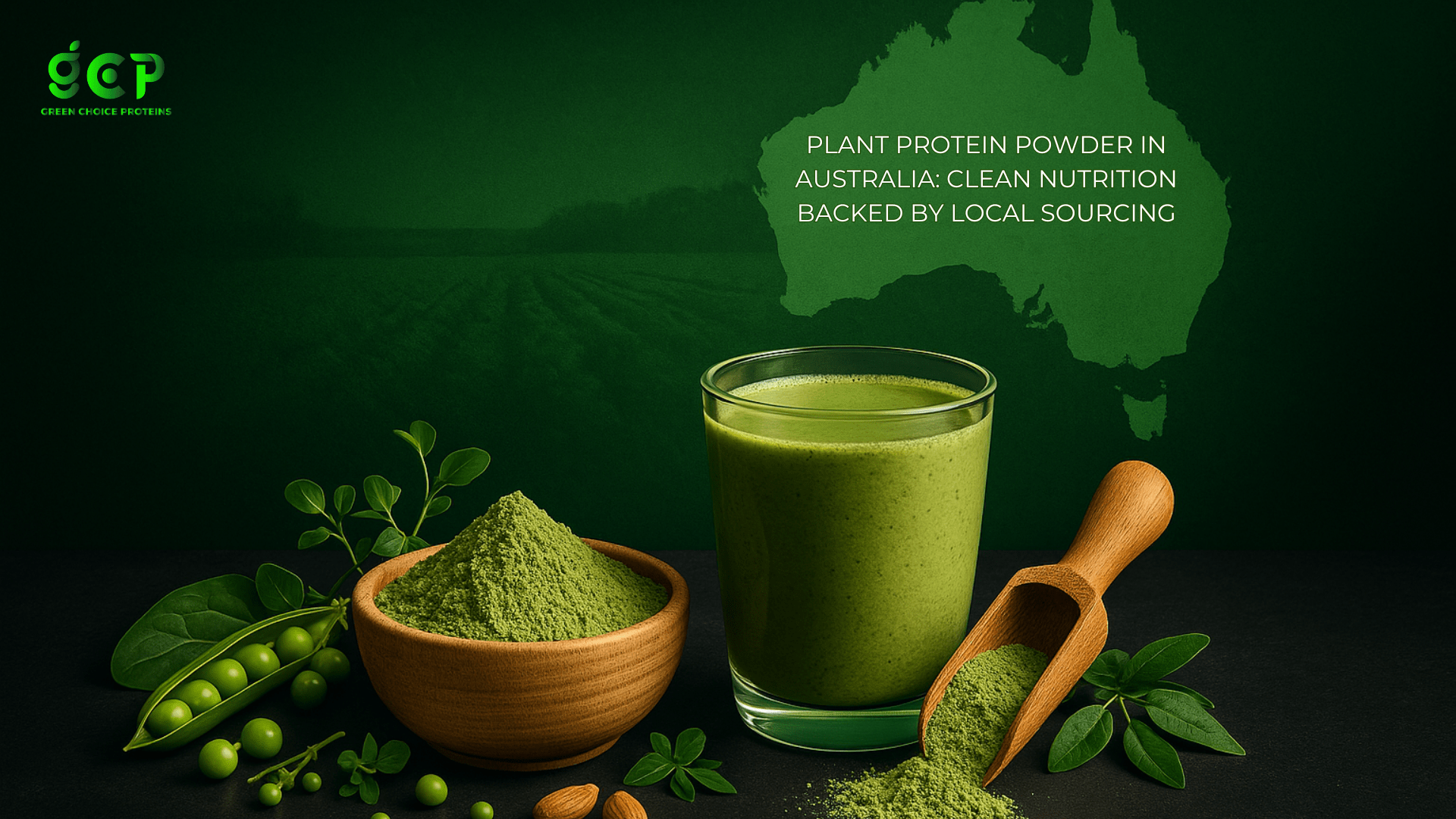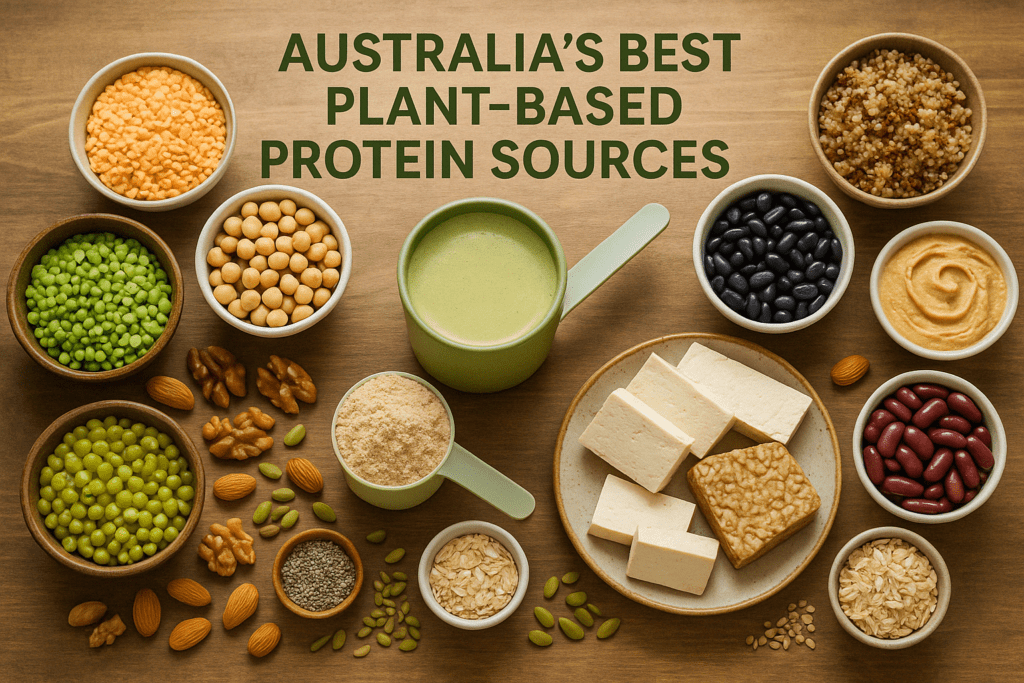

As the plant-based movement grows stronger across Australia, more individuals are re-evaluating their diets and asking an essential question: “Can I get enough protein from plants?” The answer is a resounding yes. With a wealth of nutritious and diverse foods available, it’s easier than ever to embrace a plant-powered lifestyle without sacrificing protein intake.
Whether you follow a vegan, vegetarian, flexitarian, or whole-food diet, integrating High-Protein Plant-Based Foods in Australia can help you reach your wellness goals—be it weight loss, muscle building, improved digestion, or increased energy. The key lies in selecting the right combination of foods that offer both complete and complementary amino acids. With reliable brands like Green Choice Proteins (GCP) offering premium plant protein powders sourced from Australian farms, it’s never been more convenient to build a high-protein plant-based diet.

Plant-based protein refers to protein obtained from non-animal sources such as legumes, nuts, seeds, grains, vegetables, and pulses. Unlike animal-derived protein, which is typically complete in terms of its amino acid profile, plant-based protein often needs to be combined strategically to provide all nine essential amino acids required by the human body.
However, some plants—like quinoa, soy, hemp, and blended powders (e.g., pea and chickpea)—do offer complete proteins on their own. This means that when you understand how to combine ingredients or incorporate high-quality plant-based supplements like GCP, you can enjoy a fully nourishing, muscle-building diet without any animal products.

Protein is crucial for rebuilding and repairing muscle tissue, making it an essential nutrient for athletes, fitness enthusiasts, and anyone staying active. A plant-based diet rich in high-protein foods like lentils, tofu, tempeh, quinoa, and GCP powder provides the amino acids needed to stimulate muscle protein synthesis. With regular strength training and the right diet, these foods can help build strong, lean muscle just as effectively as animal protein sources.
Protein not only helps maintain muscle mass during weight loss but also plays a role in appetite regulation and metabolic efficiency. High-protein plant-based foods digest more slowly than simple carbohydrates, which leads to a prolonged feeling of fullness, reduced snacking, and better portion control. Incorporating protein-rich snacks like hummus, roasted chickpeas, or a GCP protein smoothie can help support a sustainable, balanced calorie intake without compromising satisfaction.
Unlike animal-based proteins, plant-based options come packed with dietary fiber, antioxidants, and micronutrients that support gut health. Foods like beans, legumes, and whole grains promote the growth of healthy gut bacteria, assist in digestion, and reduce inflammation. When paired with clean plant-based protein powders like GCP—which are low-FODMAP and gut-friendly—you get the benefits of protein without digestive discomfort.
Choosing high-protein plant-based foods also benefits the planet. Plant agriculture generally uses fewer natural resources—such as water and land—compared to animal farming. It also contributes significantly less to greenhouse gas emissions. GCP, in particular, emphasizes locally grown ingredients and sustainable farming practices, reducing the carbon footprint and supporting Australian farmers and ecosystems.

Lentils are one of the most accessible and protein-dense legumes, offering approximately 18 grams of protein per cooked cup. They’re also loaded with fiber, iron, potassium, and folate, supporting heart health, energy levels, and digestion. Red, green, and brown lentils are all easy to prepare and budget-friendly.
How to Enjoy: Add to veggie stews, make lentil dahl, blend into soups, or use as a meat substitute in lasagna or shepherd’s pie.
Chickpeas, also known as garbanzo beans, deliver about 15 grams of protein per cup and are a great source of complex carbs, iron, and fiber. They’re incredibly versatile and work well in both sweet and savory dishes.
How to Enjoy: Use in hummus, roast for crunchy snacks, toss in salads, or blend into protein-rich smoothies.
Both black beans and kidney beans offer 13–15 grams of protein per cooked cup, along with ample fiber and slow-digesting carbohydrates. They support digestive regularity and help regulate blood sugar levels.
How to Enjoy: Use in burrito bowls, bean-based burgers, chili, or mash into dips and spreads.
Often called a “super grain,” quinoa provides around 8 grams of complete protein per cooked cup. It’s also rich in iron, magnesium, and fiber, making it ideal for individuals with gluten sensitivity or those following a whole-foods lifestyle.
How to Enjoy: Cook into grain bowls, serve as a side dish, make quinoa porridge, or use in tabbouleh.
Tofu provides 10 grams of protein per 100g, while tempeh can go up to 20 grams, thanks to its fermentation process and concentrated form. These soy-based proteins are incredibly adaptable and take on the flavour of marinades and sauces beautifully.
How to Enjoy: Grill tofu skewers, stir-fry with veggies, bake tempeh bacon, or toss into wraps and noodle dishes.
Nuts like almonds, peanuts, and cashews, and seeds like hemp, flax, chia, and sunflower are rich in protein, healthy fats, and essential minerals. Hemp seeds, for example, contain 10g of protein per 3 tablespoons, making them a complete and easily digestible source of protein.
How to Enjoy: Sprinkle on smoothie bowls, toast into muesli, mix into baked goods, or add to homemade granola bars.
Oats, brown rice, amaranth, and buckwheat are grains that deliver moderate levels of protein per serving, along with sustained energy and heart-healthy fiber. Paired with legumes or seeds, they become part of a complete protein combination.
How to Enjoy: Prepare overnight oats, make grain salads, cook pilafs, or pair with lentils and vegetables for a protein-rich meal.
Sometimes, it’s hard to hit your protein goals with whole foods alone—especially if you’re on the go. That’s where GCP’s plant-based protein powder stands out. Offering 20–25g of complete protein per scoop, GCP’s formula is made from Australian-grown peas and chickpeas, free from soy, dairy, gluten, artificial additives, and gums.
How to Enjoy: Mix into smoothies, add to porridge, bake into muffins, or blend into protein balls.
💚 Shop GCP protein online: gcproteins.com.au/shop

To ensure optimal muscle recovery and general health, combine legumes with grains (like lentils with rice), or pair nuts and seeds with whole grains. Alternatively, use a complete protein powder like GCP to simplify your meal planning.
Consistency is key. Aim to have a source of protein in every meal, whether that’s beans at lunch or GCP powder at breakfast. This supports metabolism, satiety, and lean body mass preservation.
If you’re physically active or aiming to gain muscle, aim for 1.6–2.0g of protein per kilogram of body weight. For general health, 0.8–1.2g/kg is a good benchmark. Use a mix of food sources and supplements to meet your needs easily.
Yes! By eating a variety of legumes, grains, nuts, seeds, and supplementing with a quality powder like GCP, you can meet all your protein requirements—whether your goal is health, performance, or weight management.
Top choices include lentils, chickpeas, quinoa, tofu, tempeh, hemp seeds, oats, and plant-based protein powders such as GCP.
No, your body can pool amino acids over the course of the day. But combining complementary proteins or using a complete blend like GCP makes it easier.
Plant proteins come with added health benefits like fiber and antioxidants, and they’re free from cholesterol. For many people, they’re also easier to digest and better for the planet.
You can shop GCP’s range of clean, allergen-free, locally made protein powders at gcproteins.com.au/shop
Whether you’re transitioning to a plant-based lifestyle or looking to optimise your nutrition, embracing high-protein plant-based foods in Australia offers an abundance of health benefits. From whole legumes and grains to clean, complete protein blends like Green Choice Proteins, there’s no shortage of options to meet your daily protein needs—naturally, ethically, and deliciously.
It’s time to empower your body with the strength of plants. Choose whole foods. Choose balance. Choose clean fuel. Start today, and experience how plant-powered protein can transform your energy, performance, and long-term health.
Join our mailing list and be the first to know about exclusive offers, new product launches, nutrition tips, and more! Elevate your plant-based journey with expert insights and special deals straight to your inbox.
Sign up today and fuel your health the Green Choice way! 💚


Where plant-based nutrition meets unparalleled quality! Fuel your health and fitness journey with our premium plant protein, crafted from the finest Australian-grown ingredients. Clean, delicious and packed with nutrition—because you deserve the best!
Copyright 2025 © GCP | All Rights Reserved | Designed by Bufferchime